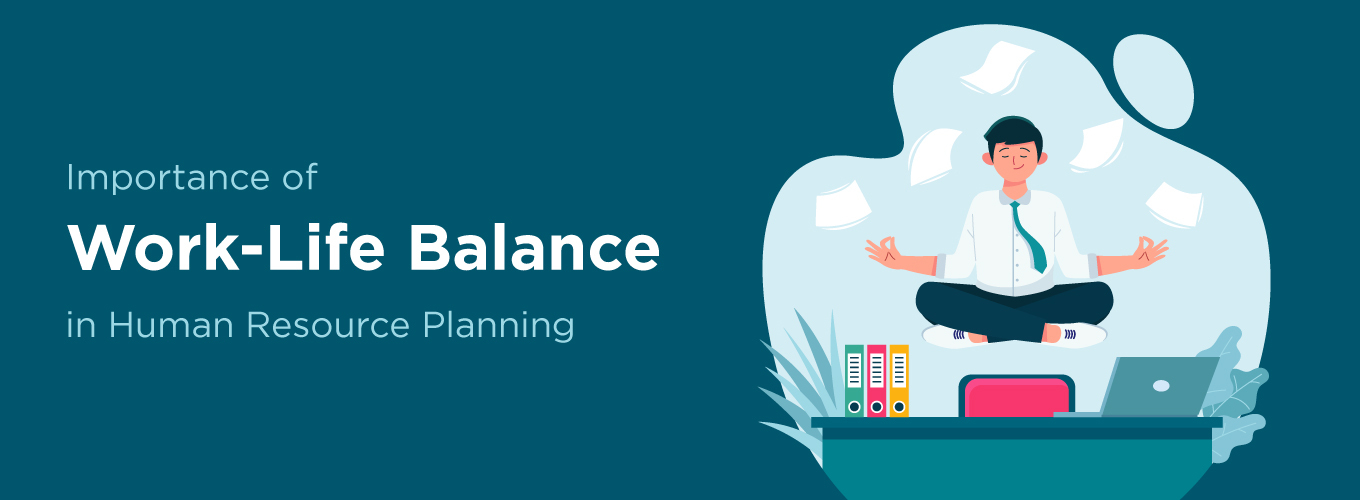What is work-life balance in human resource planning?
Human Resource Planning refers to the work-life balance, that an organization seeks to provide its employees by enabling them to strike a reasonable compromise between professional duties and personal life. This includes initiatives undertaken by HR towards establishing grounds that allow workers to balance their work-related responsibilities against hobbies, families and relaxation.
HR planning recognizes the importance of offering workers the ability to sustain both a happy personal existence as well as work. It is therefore important to maintain this balance as it enhances worker welfare, minimises burnout, and consequently leads to enhanced job satisfaction. Through work-life balance, institutions attract and keep superior employees since these are places, where they receive care for their whole selves.
Comprehensive human resource planning involves several approaches including flexible working hours, telecommuting, wellness programmes, and inclusive family-friendly practices. Such initiatives lead to high productivity and engagement among employees; besides, they reduce the rate of turnover.
Organizations that focus on work-life balance within the human resource planning process display an interest in the total growth of the employees and consequently this results in happy, motivated, and efficient workers. Such alignment promotes the existence of a good workplace culture that will ultimately lead to long-term organizational success.
Table of Contents
Why is work-life balance important in human resource planning?
Work-life balance is significant especially when it comes to human resource planning as it affects employee’s health and job performance. Human resource planning strategy involves strategies designed to ensure that workforce efficiency and health is maintained thus necessitating work-life balance.
To begin with, stress reduction among employees through ensuring good work-life balance. It lessens stress, burnout, and mental fatigue, which ultimately enhances employees’ wellness and morale. Work-life balance leads to employees being happier at work and thus more motivated and interested in the work they do.
Additionally, implementing a balance between life and work improves talent attraction and retention. Currently, employees look for work environments that blend well with their lifestyles. An organisation that provides flexible timing, telecommuting options and supportive policies attracts and retains the best employees which decrease turnover rates and hiring expenses.
In addition, a positive work-life balance enhances productivity and performance. It is proven that employees who feel this support on integrating personal commitments with work responsibilities lead to more focus, creativity, and overall productivity. It further contributes positively to organisational productivity as well as performance.
Similarly, fostering a better work-life balance is in line with the changing attitudes of society. Forward-thinking organisations that factor in the need to balance work life with other aspects of life have an edge over those that don’t. Moreover, they are perceived to be people-oriented hence better employer brands and welcoming work environments.
At last, work-life balance for human resource planning is not only about benefiting an employee but it is a strategic issue. By ensuring employee satisfaction, maintaining employees’ talents, improving productivity, and matching up with changing workers’ wants, such an organisation is not only robust but also prosperous.
What are the steps to improve work-life balance in human resource planning?
Human resource planning for better workplace-home balance encompasses a few critical techniques aimed at fostering employee health and output.
Flexible Policies: Introduce different types of flexibilities such as teleworking, flexible working schedules and compressed workweeks. Scheduling employee duties in such a way makes it possible for them to balance between work and other responsibilities.
Wellness Programs: Offer a comprehensive program in all areas including physical health, mental well-being, and stress reduction. Making resources available such as accessing gyms, counselling, and even mindfulness training promotes a healthy working lifestyle and work/life balance.
Clear Communication: Promote open discussion on work assignments and expectations. Employees can efficiently organise their schedules when there is clarity regarding timelines and priorities. This results in reductions in stress related to ambiguity.
Technology Support: Provide employees with needed technologies for remote working. The ability to gain access seamlessly to work-related resources enables them to complete their daily assignments successfully in any location other than at work.
Encourage Breaks and Boundaries: Encourage the value of rests and barriers. Allowing staff some time off during their day as well as helping them switch off from work outside office hours helps promote healthier work-life boundaries.
Training and Development: Give training on time management and priorities. Giving employees the right skills for effective workload management improves their ability to make a balance between work and life.
Lead by Example: Inspire leaders and management team to demonstrate a good example of work-life balance. Prioritising one’s health also helps inspire employees to lead a healthier lifestyle.
Through these processes, human resource planning plays an important role in fostering a workplace culture that honours work-life balance. By doing so, it increases employee job satisfaction and well-being as much as it raises productivity and keeps retention rates high for both parties involved.
Benefits of work-life Balance in human resource planning
- Human resource planning encompasses work-life balance, which provides numerous advantages for individuals and organisations in general. Firstly, it promotes the employees’ welfare as it reduces cases of workplace stress and prevents burnout. When an employee balances professional tasks with personal life, he/she has a better mood, better health, more confidence at work, and higher life fulfilment.
- It forms an integral part of the process of talent retention. Companies that emphasise work-life balance can attract excellent employees in a world where individuals look for jobs that account for their overall wellness. This leads to a lower turnover rate that results in significant financial resources saved on new hire recruitment and training.
- First of all, a good work-life balance goes a long way to boosting productivity and promote employee participation in the workplace. When employees can achieve this equilibrium, they are more focused, creative, and motivated. Such individuals tend to take their work seriously and perform better as efficiency increases, thus boosting productivity in the organisations they serve.
- Besides, promoting work-life balance develops a great company culture. This is a sure representation that is evident that an organisation considers staff welfare as the most critical factor leading to more loyalty, high moral ethics and better branding of the employer.
- Essentially, work–life integration is not just about creating a stress-free working environment, but also improving employee wellness and promoting high staff productivity. This can also place the company, amidst cutthroat competitors, as a top choice employer.
Conclusion
Human resource planning relies on work-life balance which is significant not only to human beings but also to organisations. This equilibrium is crucial because it requires a balancing act that allows people to grow as professionals and in their personal lives, where life exists.
The work-life balance represents one of the key pillars of employee welfare. It protects them from the hazards of exhaustion and chronic stress while promoting their psychological well-being and contentment. Individuals with good health can enjoy their jobs as well as engage in other activities such as investing in family commitments, personal interests, or taking care of themselves. This promotes a high-quality life, better relationships, and more happiness.
As such, work/life balance becomes an important element of employee fulfillment, while simultaneously contributing to organizational success. It is an indication that the management has the interests of workers at heart by ensuring they have a healthy working environment which will enhance productivity and put them among other organisations on top to attract the best personnel.
Frequently asked questions
1. What is the importance of a work-life balance for human resource planning?
Maintaining a balance between work and life improves employees’ well-being, efficiency attainment, and retention, which in turn makes a productive and sustainable workplace.
2. What factors may lead to better organizational success when it comes to work-life balance in human resource planning?
Employee satisfaction which in turn reduces burnout and attrition can be stimulated by a healthy work-life. This has the potential to increase productivity, enhance creativity, and lead to overall organizational success.
3. What avenues can human resource planning use to ensure work-life balance?
HR can advocate for implementing flexible schedules, remote work options, and health plans, which will underline a culture that supports employees’ work-life balance and ultimately benefits the organization as a whole.









